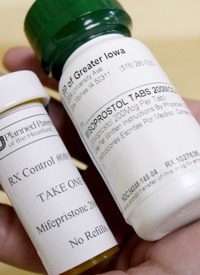
The study also found that “the rate of hospital admission jumped to 5.7 per cent for recipients of early ‘medical’ abortions — using drugs — compared with 0.4 per cent for surgical patients re-admitted for post-operative treatment.”
The popularity of the RU-486 abortion pill has grown rapidly in Australia since it was approved for sale in 2006, “as proponents cite its safety, ease, and cost-effectiveness against surgery, as well as the option it gives women to have an induced miscarriage in the privacy of their own home,” reported the Australian. According to Australia’s drug regulatory agency, the Therapeutic Goods Administration, over 11,000 prescriptions for RU-486 have been filled in the past five years, out of some 100,000 abortions that are performed each year in the country.
The study revealed that while the risk of women suffering severe hemorrhaging was one in 3,000 for surgical abortion, the risks rose dramatically to one in 200 for chemical abortion. And the rate for hospital admission for an infection was one in 1,500 for surgical abortion, but skyrocketed to one in 480 for an abortion via RU-486.
Dr. Ea Mulligan, one of the lead researchers for the study, downplayed the seriousness of the findings, telling the Australian, “My thinking is that as we get more used to using this drug, that follow-up surgical intervention will come down…. We are kind of at the beginning of the learning curve.”
But just as pro-life activists here in the United States have said, Margaret Tighe of Right to Life Australia warned that the findings merely confirm the inherent danger of using the notorious abortion pill. “We always said that taking RU486 would have a very deleterious effect on women’s health,” she commented, noting that “taking a pill seems very easy, but what we are seeing here is there can be quite a lot of complications.”
Similarly, Teresa Martin of the Australian organization Cherish Life said that the latest study “blows out of the water arguments advanced by mifepristone pioneer Caroline de Costa for wider availability of the drug.” De Costa is an Australian obstetrician who, according to the Australian, played a lead role in getting RU-486 to market in the country and setting up its use. She also downplayed the alarming statistics for medical complications associated with the abortifacient, telling the Australian that the large numbers represent “the first figures for a procedure that is new for the people doing it.” She argued that because the “abortion process occurs at home … it is not surprising that a small number presented to [emergency rooms] if they were concerned … about the amount of pain and/or bleeding.”
While RU-486 has gained wide use in the United States and elsewhere and has been heavily marketed as a safe alternative to surgical abortion, it has remained controversial because of the deaths and trauma associated with its use. Writing in National Right to Life News Today, pro-life columnist Dave Andrusko noted that his organization “has run many, many stories about complications associated with the use of RU486.” He recalled, for example, that “a 2009 study from Finland found that 20% of the women using the abortion pill suffer[ed] at least one significant complication and that nearly 4% reported two or more complications or ‘adverse events.’”
Andrusko also pointed to a National Right to Life fact sheet entitled "RU486, the Abortion Pill: Risks and Dangers," which offers vivid examples of the consequences women have faced in using RU-486, along with a whole host of possible complications and dangers associated with the use of the drug. For example:
• “In France, a woman suffered heart failure and died after taking RU-486 in combination with its accompanying prostaglandin.” And here in America, “one of the women participating in the U.S. trial of RU-486 nearly bled to death after taking the abortion drugs.”
• Women with the following conditions or symptoms have been kept out of tests of RU-486 “for fear that the drug might prove dangerous or deadly to them”: cardiovascular risks like high blood pressure, obesity, diabetes, and cigarette smoking; asthma and bronchitis; anemia or blood clotting disorders; menstrual irregularities, fibroids, or endometriosis; allergies; epilepsy; a history of problem pregnancy; pelvic inflammatory disease; or a history of liver, stomach, intestinal, or kidney disease.
• "There are over 1.3 million abortions performed in the U.S. each year,” notes the fact sheet. “We are told that 20-33% of abortions performed in France are chemical abortions. If U.S. use mirrored French use, and U.S. abortions remained stable,” among the complications related to RU-486 that one could expect would include: between 5,463 to 9,014 cases of hemorrhaging per year, along with the same number of needed surgical interventions to stop the bleeding; between 2,731 and 4,507 required hospitalizations per year; and between 515 and 850 needed transfusions per year.
Additionally, LifeSiteNews.com reported that since 2000, when the Food and Drug Administration approved RU-486 for use in the United States, “at least six American women have died of complications from medically induced abortion. Abroad, the Italian Journal of Gynecology and Obstetrics in 2008 reported 16 maternal deaths associated with RU-486, leading the Italian Senate to delay sale of the chemical abortion regimen.”
Wendy Wright of Concerned Women for America pointed out that in the United States RU-486 has been used as a “tool of the abortion movement to try and make abortion easy to access, make it seem as if it’s a simple process that any woman can undergo, and even seem to give the impression that you don’t even need a doctor around to do an abortion.” But while abortion proponents continue to insist that RU-486 is safe, both anecdotal and clinical evidence confirm, as the Australian study clearly shows, the abortion pill is “certainly not safe for the pre-born child and also not safe for the mother,” said Wright.
Photo: AP Images



